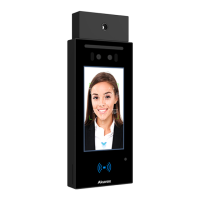
Do you have a question about the Akuvox A05 Series and is the answer not in the manual?
| Audio | Built-in microphone and speaker |
|---|---|
| Connectivity | Ethernet, Wi-Fi |
| Power Supply | PoE or 12V DC |
| Ethernet | 10/100Mbps |
| Installation | Wall-mounted |
| Model | A05 Series |
| Display | 5-inch touchscreen |
| Camera | 2MP |
| Communication Protocol | SIP |
| Wi-Fi | 802.11 b/g/n |
| Processor | Quad-core |
| Storage | 8GB |
Provides basic product, network, and account information.
Covers DHCP/Static IP settings and device deployment configurations.
Includes audio/video settings like Live stream, RTSP, ONVIF, MJPEG.
Details input type, relay, PIN, RF card, facial recognition, and logs.
Covers time, language, security notifications, and door prompt text settings.
Includes firmware upgrade, device reset/reboot, and PCAP configurations.
For password modification, tamper alarm, and web interface auto logout.
Concerns LED, ODSP, screensaver, volume, and third-party integration settings.
Lists common tools for convenient device setup and management.
Configures the device display language for user interaction.
Sets the device time and date, supporting NTP synchronization.
Enables/disables card reader LED lighting and sets operational timing.
Configures white light for enhanced facial recognition and QR code scanning.
Sets the device to enter an idle status for screen protection after inactivity.
Configures tamper alarm volume and ring volume levels.
Sets up DHCP or static IP address, subnet mask, and default gateway.
Configures relay switch trigger delay, hold delay, and status.
Configures network-based door access control actions via web relay.
Allows creating and managing daily, weekly, or monthly access schedules.
Enables importing or exporting schedule data for efficient management.
Provides options to edit or delete existing door access schedules.
Sets up RF card access for unlocking doors, including code format configuration.
Configures facial recognition settings and allows uploading user photos.
Speeds up configuration by importing user-specific door access files in batch.
Details QR Code, Bluetooth, HTTP, Exit Button, and Body Temperature unlock methods.
Configures the tamper alarm function to detect unauthorized device removal.
Configures email, FTP, and TFTP notifications for security alerts.
Captures MJPEG format monitoring images and allows setting image quality.
Displays real-time video from the access control terminal on the web interface.
Monitors RTSP streams for real-time audio/video feeds from the device.
Configures ONVIF for video searching and access by third-party devices like NVRs.
Records and allows searching of door access history events.
Records and allows checking of temperature log entries.
Configures system log levels and export options for debugging purposes.
Captures data packets for debugging and troubleshooting network issues.
Explains the principle of auto-provisioning using third-party servers and protocols.
Describes general and MAC-based configuration file formats for auto-provisioning.
Allows scheduling automatic provisioning of devices at specific times.
Configures DHCP options for obtaining auto-provisioning URLs from a DHCP server.
Manually sets up specific server URLs for firmware and configuration file downloads.
Configures the Wiegand interface for integration with external third-party devices.
Configures the RS485 interface for integration with external third-party devices.
Configures OSDP settings for secure communication with third-party devices.
Allows changing the administrator password for secure web interface access.
Sets the automatic log-out timing for the web interface for enhanced security.
Restarts the device or schedules automatic device restarts.
Resets the device system to its original factory settings.